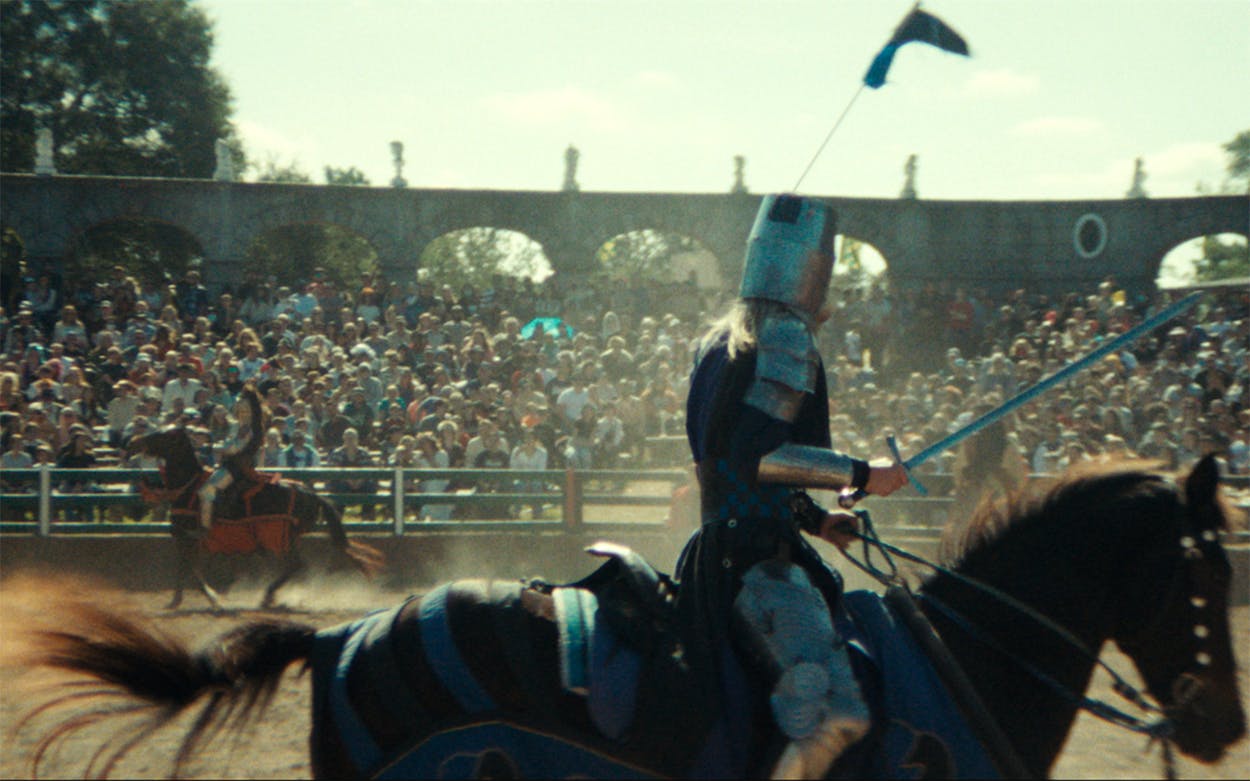Almost every year since 2016, my friends and I pack our cars with booze, bustles, corsets, and camping equipment and head east for the Texas Renaissance Festival, the largest ren faire event in the country. I grew up in Grimes County, fifteen minutes outside the fairgrounds in Todd Mission, and have attended the festival intermittently my whole life. My annual return is akin to a homecoming; I almost always see at least a few folks from my past, slinging turkey legs or driving horse carriages. And so it was with eager anticipation, and just a tad territorialism, that I shuffled into the Saturday evening South by Southwest screening of the first episode of Ren Faire, a three-part HBO docuseries coming this summer. Ren Faire centers a new (to me) story plotted along old lines of conflict: a king is vacating his throne, and two eager hopefuls must vie to be his replacement.
The king in question is George Coulam, the octogenarian Willy Wonka–type figurehead who created the Texas Renaissance Festival, and the world that surrounds, it fifty years ago. In accordance with his nine-year plan to keel over and die—the man has vision boards with his own death on them—the documentary finds him taking steps to find a successor (and a female companion) before he kicks it.
Jeff Baldwin is George’s current right-hand man, the faire’s general manager, an eternal starry-eyed theater kid and longtime ren-fest employee who believes his years of service and deep devotion to the king will earn him a final seat on the throne. He’s up against Louie Migliaccio, a.k.a. “Lord of the Corn,” who, with his gray topknot, handy vape pen, and interminable stash of Red Bull, cuts a convincing millennial capitalist villain. He started his ren-fest empire with a kettle corn stall several years back and has now amassed enough moneymaking faire businesses (a Victorian-era cocktail bar, for one) to potentially purchase the whole festival from Coulam. Ren Faire press also hints at a third contender: a retired elephant trainer.
This question—Who will rule the empire next?—is at least as old as the Renaissance itself, and it has been told a million times, recently on Ren Faire’s own streaming service in Game of Thrones and Succession. Baldwin, ever the dramatic, compares his plight to that of Cordelia, King Lear’s “truest daughter.” As the first episode unwinds, the narrative unfolds as you’d expect, with all of the suspense, scheming, and striving the takeover trope implies. But told among the elements of fiefdom (dragons, knights, swords) made absurd by modern anachronisms (cellphones, facial piercings, plastic cups), the ancient story is fresh and comedic. At stake is the future and legacy of a multimillion-dollar event that’s drawn generations of families for a full fifty years and become a veritable Texas tradition for many. Should Baldwin the loyal servant win out, the faire will remain much the same. But let Migliaccio have his way, and the festival could modernize and expand along as-yet-untold paths.
The juxtaposition inherent in the Texas Renaissance Festival—real and artifice, old and new—infected director Lance Oppenheim’s filmmaking approach. He bills the series a “docu-fantasia” and allows the lines of reality to blur. That designation feels in some ways intractable from the subject matter: cinematic scenes of jousting and fire dancing might always feel fantastical, and subjects are sometimes filmed in costume (one memorable outfit consists of fairy wings and a cigarette). But the fantasy extends to editorial choices as well. In the final scene of the first episode, after a well-timed phone call, Baldwin experiences colorful, oscillating hallucinations. Asked about the manufactured mirage after the screening, Oppenheim said the documentary’s story is real, while the storytelling is at times a “creative treatment” of the truth.
Perhaps most importantly, the series is funny. Of course it is, when it takes for its subject grown men in tights fighting over a fake, if still valuable, crown. The filmmakers found a real gem of a subject in King George, whose obsessions with death, women, and his collection of angel statues offer an eccentric B plot to the main event. I am as anxious to learn how his hunt for a female companion—conducted via sugar daddy sites and piloted by a patient assistant—will shake out as I am to learn who will ultimately capture the throne. Played against Coulam, Baldwin’s sniveling servant and Migliaccio’s blustery renegade offer up their own moments for a well-rounded ensemble cast.
Every rennie knows that the real thrill of the faire is the thrill of escape from the mundane modern world. In building its own kooky, beautifully shot, slightly demented fairy-tale world into which a viewer can escape, Ren Faire succeeds mightily. And so, to this work, this rennie gives a full-throated, stein-lifting “Huzzah.”








